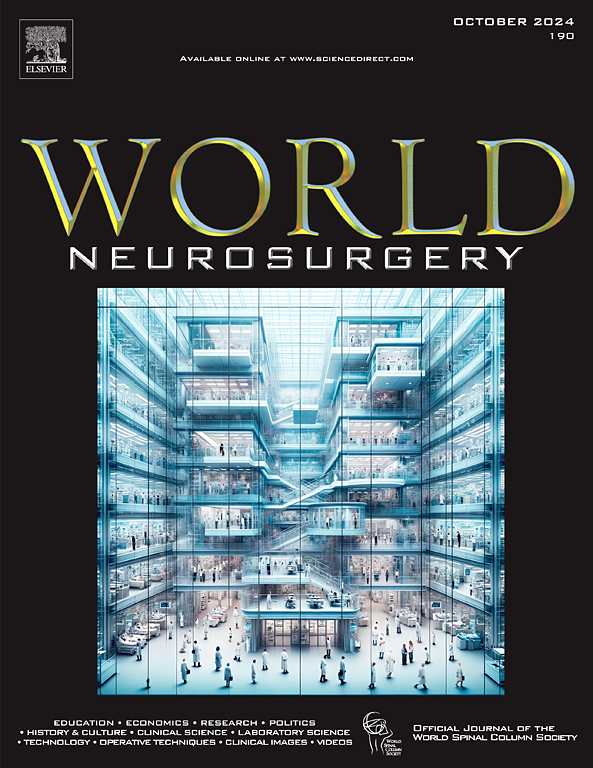Stereotactic Radiosurgery for Choriocarcinoma Brain Metastases: Illustrative Case Presentation and Systematic Review
IF 1.9
4区 医学
Q3 CLINICAL NEUROLOGY
引用次数: 0
Abstract
Background
Choriocarcinoma (CC) is a rare and aggressive form of germ cell tumor. There is limited evidence describing clinical outcomes in patients with primary CC and brain metastases (BM). Only a few single case reports have documented the use of stereotactic radiosurgery (SRS) for CC BM.
Methods
We retrospectively assessed patients who were treated with SRS for pure CC BM from 1998 to 2024. Lesion follow-up sizes and local tumor control status were evaluated after SRS treatment using response evaluation criteria in solid tumors criteria. A comprehensive literature search was performed for CC BM in accordance with PRISMA guidelines.
Results
In our series, 3 patients with 7 CC BM underwent SRS. Two were male with testicular CC and one was female with gestational CC. The median diameter of the lesions was 8 mm, with a median volume of 0.14 cm3 at treatment. Magnetic resonance imaging at 3 and 6 months showed reductions in median diameters to 6 mm and 4 mm, respectively. At the last follow-up visits, one lesion had local progression at 15 months after SRS and 1 lesion had sustained complete response. The systematic review yielded 249 articles. After screening, 18 reports were identified for CC BM. Among these reports, only 3 single case reports document outcomes of SRS for CC BM.
Conclusions
SRS is a feasible and viable approach for CC BM, particularly in cases where immediate surgical management is not necessary. This is the largest report to date evaluating the outcome of CC BM treated with SRS.
立体定向放射外科治疗绒癌脑转移:病例展示和系统回顾。
背景:绒癌(CC)是一种罕见的侵袭性生殖细胞肿瘤。报告原发性CC和脑转移(BM)患者疗效的证据有限。迄今为止,仅有少数病例报告了使用SRS治疗CC脑转移瘤:我们回顾性评估了 1998-2024 年间接受 SRS 治疗的纯 CC BM 患者。采用 RECIST 标准评估了 SRS 治疗后的病灶随访大小和局部肿瘤控制状况。根据《系统综述和荟萃分析首选报告项目》指南,对 CC BM 进行了全面的文献检索:在我们的系列研究中,有 3 名患有 7 种 CC BM 的患者接受了 SRS 治疗。其中两名男性患者患有睾丸CC,一名女性患者患有妊娠CC。病灶的中位直径为 8 毫米,治疗时的中位体积为 0.14 立方厘米。3个月和6个月后的核磁共振成像显示,病灶的中位直径分别缩小至6毫米和4毫米。在最后一次随访中,一个病灶在SRS治疗后15个月出现局部进展,一个病灶持续完全反应。我们的系统综述共收到 249 篇文章。经过筛选,共发现18篇关于CC BM的报道。结论:SRS 是一种可行且有效的治疗方法:结论:SRS 是治疗 CC BM 的可行方法,尤其是在不需要立即手术治疗的病例中。这是对使用 SRS 治疗 CC BM 的结果进行评估的最大规模报告。
本文章由计算机程序翻译,如有差异,请以英文原文为准。
求助全文
约1分钟内获得全文
求助全文
来源期刊

World neurosurgery
CLINICAL NEUROLOGY-SURGERY
CiteScore
3.90
自引率
15.00%
发文量
1765
审稿时长
47 days
期刊介绍:
World Neurosurgery has an open access mirror journal World Neurosurgery: X, sharing the same aims and scope, editorial team, submission system and rigorous peer review.
The journal''s mission is to:
-To provide a first-class international forum and a 2-way conduit for dialogue that is relevant to neurosurgeons and providers who care for neurosurgery patients. The categories of the exchanged information include clinical and basic science, as well as global information that provide social, political, educational, economic, cultural or societal insights and knowledge that are of significance and relevance to worldwide neurosurgery patient care.
-To act as a primary intellectual catalyst for the stimulation of creativity, the creation of new knowledge, and the enhancement of quality neurosurgical care worldwide.
-To provide a forum for communication that enriches the lives of all neurosurgeons and their colleagues; and, in so doing, enriches the lives of their patients.
Topics to be addressed in World Neurosurgery include: EDUCATION, ECONOMICS, RESEARCH, POLITICS, HISTORY, CULTURE, CLINICAL SCIENCE, LABORATORY SCIENCE, TECHNOLOGY, OPERATIVE TECHNIQUES, CLINICAL IMAGES, VIDEOS
 求助内容:
求助内容: 应助结果提醒方式:
应助结果提醒方式:


